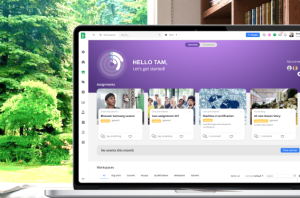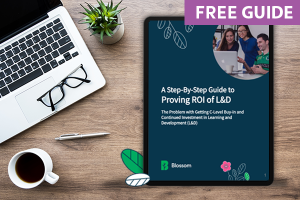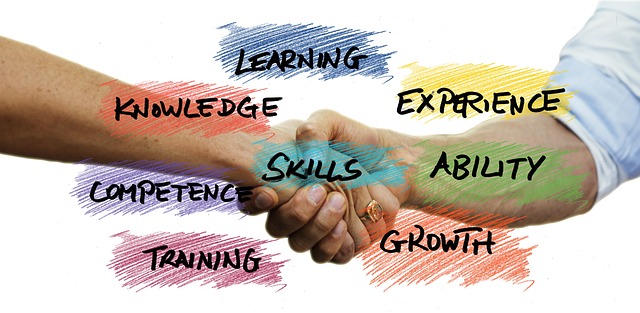Research upon research shows effective leadership and management are crucial for organisational success. Yet, many companies overlook the pivotal role that managers play in increasing learner motivation and engagement for workforce development. This means companies face several negative effects, such as decreased employee performance, longer time to competency, and limited growth.
When managers, team leaders, and supervisors take proactive steps to support their team’s engagement in education and training, they become effective facilitators of employee development and help overcome barriers to learning. However, this requires a multi-faceted approach.
This guide will help you make the most of your managers to ensure that employees are capable, confident, and continuously improving,
Learn why these important colleagues are the missing link to L&D success. Discover six practical strategies to help your managers become effective facilitators of employee development.
Maximise managers for L&D success
Considering that the number one motivator for employees is the opportunity for career growth, managers, given their close familiarity with their team members, hold a unique vantage point in supporting employee development and identifying strengths, areas for improvement, and obstacles.
Because successful workforce development doesn’t start and end with L&D, effective managers can build momentum for learning within their teams by being transparent, consistent, and fair. When managers openly share information about the latest training and listen to employees’ concerns without judgment, employees gain trust in their managers and feel respected. As a result, they are more likely to be open to feedback, take initiative, and actively engage in their own development.
Research shows that 69% of employees plan to stay longer with their employer if they see opportunities for skill development. Competent managers who encourage L&D reduce employee turnover and boost participation. Additionally, employees who move internally are 75% more likely to stay, highlighting the positive impact of effective management on retention and career growth.
By making the most of managers to actively support employee development, organisations unlock the full potential of their people and drive long-term success. This involves partnering with managers and adopting an integrated approach to L&D, which includes:
- Equipping managers to recognise the importance of lifelong learning and instill the same mindset in their team while also developing their own soft skills, such as communication and relationship-building.
- Support managers in working ‘with’ their employees rather than taking an authoritarian approach to identify training opportunities, set achievable goals, and track progress through leadership development programmes.
- Empowering managers to consistently emphasise the value of continuous learning by role-modeling and sharing their own learning journey to inspire others while providing tools for diverse learning and collaboration resources.
Improve the skills and competencies of your managers
As managers are typically the first point of contact for employees considering L&D opportunities, they need key competencies and skills in communication, coaching, influencing, and strategic thinking to explain the benefits of continuous improvement.
This could lead to misunderstandings about the relevance and value of training programmes, decreased engagement as managers find it challenging to motivate employees to actively participate in learning initiatives, and resistance from workers when introducing new ideas or learning programmes.
Enhance the capabilities of your managers, team leaders, and supervisors to address these problems and create a democratic learning environment by providing:
- Personalised learning paths. Help managers understand the direct connections between their learning experiences and daily tasks. For instance, if a manager aims to enhance their coaching skills, offer targeted training modules on effective coaching techniques and involve them in real-life coaching scenarios with their team.
This approach integrates learning into their work, enabling managers to apply new knowledge immediately and observe its impact on their team’s development.
- Skill assessment and gap analysis. Provide managers with the necessary tools to assess their current skills and identify areas for improvement. This clarity not only motivates them to actively participate in learning opportunities but also enables them to plan strategically without compromising team objectives.
- Supportive learning environments. Offer ways for managers to network and share experiences with their peers. Managers can ask questions, seek clarification, and collaborate, reducing feelings of isolation and enhancing engagement with management activities.
Utilising tools like Blossom can streamline these initiatives, offering real-time insights that empower managers to prioritise their professional growth while effectively managing team responsibilities.
Since Blossom offers personalised learning recommendations tailored to individual preferences, roles, and skill gaps identified through assessments, it ensures relevance and alignment with personal goals. This empowers managers to take ownership of their career development.
Our learning transformation platform offers anytime, anywhere access to learning materials. This flexibility and accessibility make it easier for managers to engage in learning activities at their own pace and convenience. Considering two-thirds of people feel their workload is out of control for at least three days per week, Blossom’s flexibility allows managers to fit learning activities into their schedules more seamlessly. This supports their professional development and helps them manage their workload more effectively by integrating learning into their daily routines.
- “Blossom’s functionality is always relevant and geared up to meet the needs of our widely dispersed and remote teams, as well as those of our distributors too.” –Jazz Vershinin, Director of Learning & Development at Bezeq International
Facilitate interactive and collaborative learning experiences through features like knowledge-sharing forums, playlists, and a centralised “source of truth” knowledge repository. These features promote engagement and reduce feelings of isolation because they encourage continuous interaction, knowledge exchange, and collective learning among team members.
Source
Strategies to empower managers as learning facilitators
Let’s start by asking: how do you know the issues affecting workforce development? When designing a workforce development strategy, understanding the insights into the current challenges and opportunities your organisation faces is essential.
Why?
Firstly, managers are crucial to understanding the challenges people face when it comes to reskilling and upskilling. Because they are in a unique position to observe day-to-day operations and identify areas where employees struggle or where there are inefficiencies, managers can offer valuable insights into the specific skills gaps. They can highlight areas where additional training would have the most significant impact.
Plus, managers often act as a bridge between employees and upper management. They can advocate for their team’s needs and ensure workforce development strategies are tailored to address real-world challenges.
Help your managers to inspire, guide, and support their teams to create a learning culture. Let’s explore how L&D can further equip managers to be effective learning facilitators.
1. Set clear expectations
When setting clear expectations about L&D opportunities, it is essential to ensure that employees understand what is expected of them and what they can expect in return.
Educate managers to focus on solving problems your learners experience rather than simply sharing learning objectives, such as improving time management skills. For example, instead of asking employees to take a course on specific software, managers can frame the training as a solution to a problem they face and say, “To reduce the time spent on manual data entry, we are offering training on this new software that will automate the process and save you many hours each week.”
Managers can make learning more relevant and engaging by framing L&D opportunities as solutions to real problems and aligning them with employees’ needs and goals. This helps employees see the bigger picture and understand why L&D initiatives are worthwhile, increasing engagement and improving performance.
2. Support employee health and wellbeing
Globally, employee well-being declined from 35% to 34% in 2023. When it comes to L&D, disengaged workers are less likely to actively participate in or show enthusiasm for growth opportunities and skill development within L&D. As a result, this can lead to stagnant professional development and higher job dissatisfaction.
In addition, high levels of stress and poor mental health can affect cognitive functions such as memory, attention, and problem-solving skills. This makes it harder for managers and workers to absorb new information, retain knowledge, and apply new skills effectively during training sessions. With 54% of actively disengaged workers reporting experiencing a lot of stress the previous day, supporting individuals to improve their well-being has a huge impact on their development.
Maximise your managers’ potential through training in health and well-being topics like stress management and mental health. This equips them to support their own and their employees’ well-being effectively. Lifestyle e-learning modules, for example, can offer tips on workload management, setting boundaries, and prioritising self-care. Flexible learning options, such as self-directed and asynchronous courses, cater to diverse work patterns, job roles, and personal preferences without increasing stress.
3. Lead by example
Staff often look to managers for guidance and leadership. So when managers show positive behaviours and practices, like effective communication, openness to feedback, and a commitment to continuous learning, they set a strong example for their team and inspire the same in their employees. This shared sense of purpose and belonging boosts engagement in education and training.
We know this isn’t easy.
Busy workloads and ever-changing priorities can signal that learning is not a priority. Negative or cynical attitudes towards education and training can influence staff to adopt a similar mindset, reducing motivation to start learning new skills or complete training programmes.
This is where skilled managers excel in motivating and inspiring their teams to participate in upskilling and reskilling initiatives.
Empower your management teams to share their own learning experiences and insights with staff. Knowledge-sharing platforms and dedicated channels enable managers to share case studies or post videos discussing their learning experiences and insights.
These practices inspire other employees to collaborate, share best practices, and learn from each other’s experiences. By offering opportunities for social learning, mentoring, and knowledge exchange within the team, you can make the most out of everyone’s expertise and wisdom.
4. Measure and evaluate progress
There’s a well-known saying: “You don’t know what you don’t know.” Therefore, when implementing a new learning initiative, how do you know if it’s working?
Without proper assessment, managers and staff may lack clear goals and benchmarks, resulting in aimless development efforts. This can cause missed opportunities to identify strengths or improvement areas and wasted resources on ineffective training if progress isn’t monitored.
Your managers can play a vital role in tracking metrics and evaluating the impact of learning programmes on their teams. To prevent missed opportunities, support managers in assessing the effects of learning initiatives. Equip them with the tools necessary to monitor team performance, productivity, and skills development efficiently. Enable managers to gather employee feedback and analyse metrics to make informed decisions about scheduling employee development activities.
Blossom, for example, has a comprehensive manager dashboard that gives senior staff comprehensive information covering the who, what, when, and how of L&D. These insights enable managers to make better decisions about giving the right amount of time needed for development without impacting team goals.
5. Leverage technology
In 2024 and beyond, we shift from discussing emerging technologies, such as AI (artificial intelligence), to taking decisive action.
Rather than just using technology to create learning content, leverage it to provide real insights into L&D performance and engagement. People data and analytics enable managers and L&D teams to quantify the return on investment (ROI). By capturing and discovering knowledge, developing skills, personalising learning, and career paths, and using data to inform talent development, managers become conductors of their own orchestra.
Because learning transformation platforms, such as Blossom, use AI and machine learning to analyse learner behaviour, preferences, and performance, it enables managers to align training with individual interests and career goals, adjusting the content difficulty to match progress. This keeps employees engaged and appropriately challenged, thereby boosting managers’ confidence.
Comprehensive reports help managers gain deeper insights into learning and skills development. By monitoring performance and promptly addressing issues like time constraints or resource allocation, managers can swiftly take action to overcome challenges. This ensures that employees maintain enthusiasm and motivation for learning.
Source
6. Give managers a seat at the strategic table
Remember our earlier point: “Successful workforce development doesn’t start and end with L&D.”
Managers are best placed to understand the specific skills and knowledge gaps within their teams. Their insider knowledge can help you develop an L&D strategy for success.
Involving managers in discussions ensures alignment of learning initiatives with broader business objectives, focusing efforts on areas that directly contribute to L&D success. This tailored approach enhances the relevance and impact of learning initiatives based on evidence, not assumptions.
Plus, when managers are involved in the decision-making process, they are more likely to support and promote these initiatives to their teams. Their buy-in increases employee engagement and participation as employees understand how training is relevant and beneficial.
Empower your managers to be effective facilitators of employee development
There’s no doubt managers play a crucial role in driving employee performance, engagement, and development, yet their impact is often overlooked.
This oversight can lead to decreased employee performance, reduced engagement, higher turnover rates, and stagnant development. By equipping managers to recognise the importance of lifelong learning and giving them the tools and skills to be effective facilitators of employee development, you can advance your L&D efforts.
Empower your managers to champion employee development with Blossom. Schedule a demo today with one of our friendly experts.








